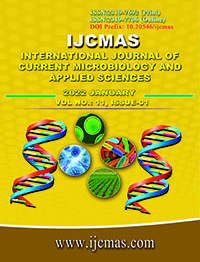


 National Academy of Agricultural Sciences (NAAS)
National Academy of Agricultural Sciences (NAAS)

|
PRINT ISSN : 2319-7692
Online ISSN : 2319-7706 Issues : 12 per year Publisher : Excellent Publishers Email : editorijcmas@gmail.com / submit@ijcmas.com Editor-in-chief: Dr.M.Prakash Index Copernicus ICV 2018: 95.39 NAAS RATING 2020: 5.38 |
Four marine microalgal strains viz. Pavlova sp. ABT 102, Chromulina sp. ABT 103, Thalassiosira sp. AMS 5 and Chlorella sp. AMS 6 were tested for their biomass and lipid productivities through bench-scale studies to assess their potential for production of value added products. Among the four different marine microalgal strains Pavlova sp. ABT 102 isolate showed maximum volumetric biomass productivity of 0.048 g L-1d-1 followed by Chlorella sp. AMS 6 (0.035 g L-1d-1), Thalassiosira sp. AMS 5 (0.021 g L-1d-1) and Chromulina sp. ABT 103 (0.019 g L-1d-1). The highest volumetric lipid productivity was recorded by Chromulina sp. ABT 103 (11.12 mg L-1d-1) followed by Pavlova sp. ABT 102 (10.65 mg L-1d-1), Thalassiosira sp. AMS 5 (8.77 mg L-1d-1) and Chlorella sp. AMS 6 (7.73 mg L-1d-1). Among four algal strains, Chlorella sp. AMS 6 could effectively utilise sodium bicarbonate as an external inorganic carbon source in the growth medium. It was found that the addition of inorganic carbon source (sodium bicarbonate) in the algal strain AMS 6 Chlorella sp. enhanced biomass and lipid productivity by 6.5 and 7.6%, respectively. This strain when grown in 1-m2 open raceway pond with and without CO2 supplementation showed volumetric and areal biomass productivities of 0.046 g L-1 d-1 and 6.9 g m-2 d-1 in CO2 supplemented treatment and 0.032 g L-1 d-1 and 4.8 g m-2 d-1 for control, respectively. Total lipid content of Chlorella sp. AMS 6 with and without CO2 supplementation was 28-30% and did not show significant variation. The present study showed the potential of microalga Chlorella sp. AMS 6 to be utilised for biomass and lipid production for commercial applications.
 |
 |
 |
 |
 |